In the summer of 1987, the economy of Moab and Grand County hit rock bottom. A few years earlier, as uranium prices 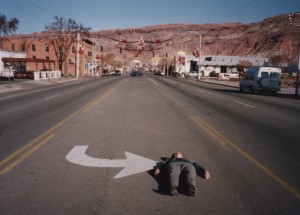 plummeted, the Atlas Vanadium Processing Mill north of town closed its doors for good. The mill, which had at one time provided hundreds of jobs now lay silent. It seemed as if the mainstay of Grand County’s economy had vanished overnight and Moab was ghost town bound. Unemployment reached 20%. Empty homes and ‘For Sale’ signs were everywhere; at one point as many as one in five homes was on the market. The way the story went: Everybody moved to Elko, where the mining industry was still viable.
plummeted, the Atlas Vanadium Processing Mill north of town closed its doors for good. The mill, which had at one time provided hundreds of jobs now lay silent. It seemed as if the mainstay of Grand County’s economy had vanished overnight and Moab was ghost town bound. Unemployment reached 20%. Empty homes and ‘For Sale’ signs were everywhere; at one point as many as one in five homes was on the market. The way the story went: Everybody moved to Elko, where the mining industry was still viable.
Moab’s politicians and promoters tried to stop the town’s dwindling population and shrinking tax base but Moab was hemorrhaging to death. For a while, in the early 80s, as the Department of Energy searched for a place to store the nation’s high level nuclear waste, a remote location in San Juan County, just a thousand feet from the boundary of Canyonlands National Park became one of the primary sites for the “repository.” The plan was to excavate a huge chamber in the massive salt domes, thousands of feet beneath the surface and store the radioactive material in canisters. The subterranean vaults and the canisters needed to withstand the forces of Nature for about 10,000 years. Considering this was a government operation, many of us were skeptical. In addition to the repository site, the associated infrastructure needed to deliver the goods would have been staggering. DOE proposed a railroad line from Moab, downriver to Lockhart Basin and the base of the Needles Overlook to the site. The view would have never been the same. But Moab, still very much a town with a mining mindset in 1982, voted 2 to 1 in favor of the Repository in a non-binding straw vote.
Moabites debated the Repository at public meetings with the same amazing regularity and enthusiasm that we devoted to other contentious issues over the years. Again maybe there just wasn’t anything else to do in those days but argue, but participation remained spirited and well-attended. Abbey’s presence at these meetings, either live or by proxy may have boosted attendance. When Ed didn’t feel up to the task, he often sent his young bride Renee’ to read his prepared comments–we usually preferred looking at her anyway.
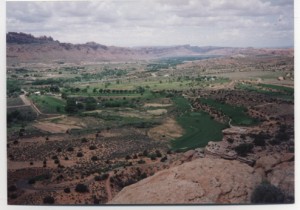 But more often, the Great Debates were waged with remarkable civility at Moab’s three greasy spoon diners, the Westerner Grill, Milt’s Stop n’ Eat, and the Canyonlands Café.’ Milt’s was named for its creator Milt Galbraith who built the Stop n’ Eat in 1951 with $10,000 he borrowed on a handshake (He paid off the loan in a year). Milt and his wife Audrey ran it 14 hours a day, six days a week, 50 weeks a year until 1982, when they finally sold the Stop n’ Eat and settled into a comfortable, if not wealthy, retirement. The Westerner and the Café’ had origin stories of their own, and the cuisine at all three was similar—-what made them so special were the seating arrangements. Even when tables or booths were available, they were few and far between and most of us were thrown into the mix at the counter. You never knew who your dining companion might be on any given day–it made for interesting conversation.
But more often, the Great Debates were waged with remarkable civility at Moab’s three greasy spoon diners, the Westerner Grill, Milt’s Stop n’ Eat, and the Canyonlands Café.’ Milt’s was named for its creator Milt Galbraith who built the Stop n’ Eat in 1951 with $10,000 he borrowed on a handshake (He paid off the loan in a year). Milt and his wife Audrey ran it 14 hours a day, six days a week, 50 weeks a year until 1982, when they finally sold the Stop n’ Eat and settled into a comfortable, if not wealthy, retirement. The Westerner and the Café’ had origin stories of their own, and the cuisine at all three was similar—-what made them so special were the seating arrangements. Even when tables or booths were available, they were few and far between and most of us were thrown into the mix at the counter. You never knew who your dining companion might be on any given day–it made for interesting conversation.
The L-shaped counter at the Westerner and the Café especially encouraged animated cross-talk from all the customers. My favorite lunch partner was an ex-uranium miner named Neldon Lemon. We’d been at the same meeting the night before and I’d overcome my fear of public speaking to stutter a few words. Neldon wasn’t pleased and when he sat down beside me and I attempted to introduce myself, he cut me off…
“I know who you are,” he snarled. “You’re one of them goddamn environmentalists that wants to lock everything up.” He looked at me fiercely.
“Well,” I said, “That must make you one of those uranium miners who wants to tear everything up.”
Neldon squinted at me for just a moment and then shook his head and chuckled. “Ah what the hell. I guess I can tolerate sitting next to you. What’s the special today?”
That’s the way it often was at the Westerner. Neldon and I became friends over the years. We chose to disagree on many issues but we were able to acknowledge and even celebrate our common interests as well. We both chose to live a simple life away from the cities, we both loved the open space and freedom of the Rural West, and we’d both chosen Moab. What else mattered really?
Still, on one issue we saw the changes in Moab very differently.
By 1985 Moab was in a state of full “economic collapse.” For the old time Moabites, the ones who had cut their teeth during the Uranium Boom days of the 1950s, Moab’s demise was an unmitigated catastrophe. It was inconceivable to them, and heartbreaking as well, that the party was over. For almost 40 years mining had sustained the Moab community and now it seemed as if the town had nothing to show for its past success except boarded up Main Street businesses and half-deserted neighborhoods.
For another part of Moab’s dwindling population, however, the downturn in the economy offered an unexpected 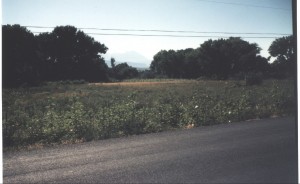 opportunity. Since the early 1970s Moab had become a mecca for a small but growing group of young pilgrims, for lack of a better word, and I was one of them. We were searching for a different kind of life, away from the polluted, frenzied madness of urban areas. In Moab, Utah, we thought we’d found it. Coming to Moab meant making some sacrifices. We knew we’d never get rich. We knew we had removed ourselves from cultural and social opportunities that we’d grown accustomed to in our old home towns. And we knew we’d probably always be a vocal but persistent minority in a very conservative part of the American West.
opportunity. Since the early 1970s Moab had become a mecca for a small but growing group of young pilgrims, for lack of a better word, and I was one of them. We were searching for a different kind of life, away from the polluted, frenzied madness of urban areas. In Moab, Utah, we thought we’d found it. Coming to Moab meant making some sacrifices. We knew we’d never get rich. We knew we had removed ourselves from cultural and social opportunities that we’d grown accustomed to in our old home towns. And we knew we’d probably always be a vocal but persistent minority in a very conservative part of the American West.
The end of the mining boom presented a disaster for some, and an unexpected dividend for others. With the exodus of the mining community, housing prices plummeted, but for the first time, all those seasonal rangers and river runners–the marginal citizens of Moab, like me–could suddenly afford to buy a home. We went from being bearded hippies to responsible land owners in eighteen months. I was one of them. I’d heard rumors that prices had fallen and I spent part of a day driving up one side street after another, stunned by the number of realty signs. Finally I spotted an old stucco home with a big yard and a magnificent spruce tree in front. A catalpa tree grew next to the driveway…it was a sign from my grandfather, for sure, who loved the catalpa’s spring blossoms but despised the seed pods. I decided to make an offer.
But I had no idea how to buy a house. I didn’t even know where to start, so I turned to Pete Parry, the superintendent at Canyonlands National Park and asked for advice. He had some and it was brief. “Go see Norma Nunn.”
Norma was a paragon of energy and assertiveness–-exactly what I needed to get me through this torture. I told her about the Locust Lane property and she knew it well. The bank owned the house, had been sitting on it for five years, unable to unload it. The last time the house sold, in 1980, it went for $51,000. Now the bank wanted $23,000.
“We’ll offer $18,000 and see what they do,” Norma explained. “How much of a down payment can you make?”
I’d checked my pitiful savings account. I barely had $2000 in the bank and during the off-season from Arches, I was living on unemployment.
“Two thousand? They might take that,” Norma assured me. “And be sure to list your unemployment compensation when you apply for the loan. That adds to your yearly income.”
I thought she was crazy. “Are you sure, Norma?”
“Absolutely….this bank does not want to deal with all these empty houses. My guess is, they’ll unload it at the price you’re offering.”
And she was absolutely right.
The next morning, I drove straight to town and walked warily to her desk. I stared disbelievingly at the documents she’d left for me. “Approved.” I was a landowner. A few weeks later, we closed the deal. My new home was a wreck. No one had lived in it for years. I didn’t even know if the plumbing and wiring worked…it was an “as is” deal. As I stood in the backyard, I felt a bit dizzy. What was I thinking? My doubting thoughts were pushed aside by a hard noise that sounded like a gravel crusher. But this was no mechanical clatter–it was Toots McDougald.
“Did you buy this goddamn house or are you just renting it?”
She was leaning against the fence that separated my place from hers. She looked to be in her 70s. Tall, angular, not an ounce of fat on her. She pulled her short closely cropped hair straight back, like Valentino. A cigarette hung idly from the corner of her mouth.
“Well?” she repeated, “Did you buy this goddamn place or not?”
I nodded slowly. “Yeah…for better or worse, I bought it.”
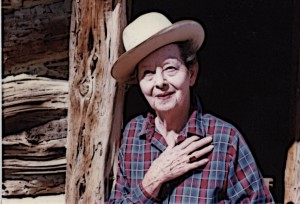 Toots shook her head. “Then I hope you paint those goddamn aluminum shingles up there on the roof. The glare from them shingles into my kitchen is just awful in the afternoon.” With that she threw down her smoke, stomped it out with her tennis shoes, and walked back inside.
Toots shook her head. “Then I hope you paint those goddamn aluminum shingles up there on the roof. The glare from them shingles into my kitchen is just awful in the afternoon.” With that she threw down her smoke, stomped it out with her tennis shoes, and walked back inside.
It became clear to me that painting the aluminum shingle might be a wise priority and as a result, Toots and I became lifelong friends. In the years to come she would feed me chocolate cake, every time she wanted me to come outside and pull goatheads and remind me that if she were 30 years younger, “you wouldn’t be over there sleeping alone, honey.” Toots told me of her adventures as a little girl in Moab, of her long trail rides to Turnbow Cabin, of the sorrows and joys she’d endured and loved over the years and decades…she painted a picture of a Moab I had never seen.
But what about now? What was to become of Moab in 1987? With a dwindling population and few if any prospects for a brighter economic future, some thought Moab might literally dry up and blow away. But others saw Moab’s economic slump as an opportunity to re-define ourselves as a community. What kind of town did we want to be as we approached the last decade of the 20th Century? It seemed as good a time as any to abandon our title of “Uranium Capital of the World.” Moab had always been pushed and shoved along by a boomtown mentality. Maybe we could finally escape that kind of erratic life.
But how to make a living…that was the rub. In the waning days of the summer of 1987, Moabites began to realize how 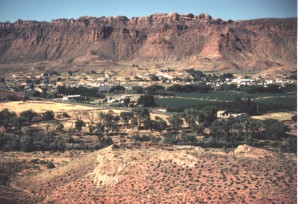 divided we still were on the subject. Rumors of a plan to build an incinerator–a toxic waste incinerator–at Cisco, Utah, 35 miles upstream from Moab, reached the local cafes. The debate began.
divided we still were on the subject. Rumors of a plan to build an incinerator–a toxic waste incinerator–at Cisco, Utah, 35 miles upstream from Moab, reached the local cafes. The debate began.
The Grand County Commission–Jimmie Walker, Dutch Zimmerman, and David Knutson–had been working behind the scenes for six months with a corporation named CoWest, Inc. CoWest specialized in building toxic waste incinerators and now they wanted to construct what they claimed would be a state-of-the-art facility on 180 acres of land in Cisco. But the land there was not zoned for that kind of use; in fact, there was no heavy industrial zone in Grand County at all, and the county commissioners, seeing a way to dramatically boost the county tax base, thought they’d stumbled across a gold mine. Or a high-tech toxic version of one. And they were convinced that the residents of Grand County would support them.
Jimmie, Dutch and Dave were all lifelong residents of Moab and survivors of the economic downturn. But none of them sensed how much Moab had changed in such a short time. Just five years earlier, in 1982, Moab residents had supported the proposed nuclear waste repository by a 2 to 1 margin, despite the fact that the facility was to be built within a thousand feet of Canyonlands National Park in San Juan County. So the fact that the commissioners enthusiastically supported an industry that would incinerate a staggering variety of toxins, from benzene and paint thinners to pharmaceutical wastes should not have surprised anyone.
But the community was enraged, or at least part of it; what no one could predict was the extent of the anger. Was this just another vocal minority? Or were we seeing a fundamental shift in Moab and Grand County attitudes? We were about to find out.
On the evening of December 2, 1987, a “toxic waste information meeting” was held at Star Hall. Commissioner David Knutson assembled a panel of CoWest officials, federal and state regulators, and private citizens. Almost 400 people crammed into the building for one of the most spirited gatherings in the town’s recent history. Dean Norris, the president of CoWest became an instant antagonist for incinerator opponents. Dressed in gray polyester and sporting a huge diamond-studded pinky ring, he barely tolerated the barrage of questions by angry residents that filled much of the evening and many of us could not have been happier; every cause needs a Bad Guy and Norris played the role perfectly.

When the shouting was over, nothing had been resolved and a showdown looked inevitable. The commission showed no sign of backing off and Moabites continued to vent their anger.
The Utah constitution provides a referendum provision to decide issues such as this; it requires 12.5% of the total number of votes in the last gubernatorial election. In Grand County, that meant 418 signatures. Three weeks later, sponsors of the referendum presented petitions to County Clerk Fran Townsend with more than 500 signatures. The petition asked that “Section 2-5-12-C of Ordinance 134, passed by the County Commission on January 25, be referred to the people for their approval or rejection at the regular election to be held November 8.”
Approval of the Initiative Petition would implement a new law that would restrict commercial uses in any Grand County zone. It said: “No zoning ordinance in Grand County shall allow: the incineration or burning of hazardous and/or toxic waste; the storage of toxic waste other than that created as a byproduct of local business or industry; the manufacture of toxins and viruses; the manufacture of synthetic pesticides, herbicides, and fungicides; the manufacture of chemical or biological weapons.”
As Election Day approached, Grand County was wound as tightly as a Warn winch. The polls closed at 7 pm and Grand County residents were glued to their television sets. But in Moab, there was no “live” local news. Thousands of us were staring instead at the Channel 6 weather scanner, waiting for the updates. Channel 6 news director Ken Davey, the “Dean of the Moab Press Corps,” would videotape himself at the courthouse, reading the latest tallies. Then he’d pop the cassette from the recorder and sprint down Main Street to the studio and play the slightly delayed video.
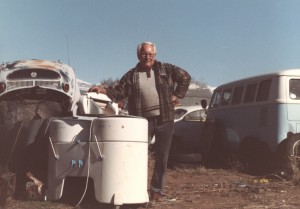 Early on, a trend became evident–the incinerator was toast. By an ever-widening margin, Grand County voted in favor of the initiative and soundly defeated the project, ultimately by a margin of almost 2 to 1. Most remarkable was the turnout itself–more than 80% of all registered voters went to the polls on November 8, 1988; it was a record then, and we have rarely come close since.
Early on, a trend became evident–the incinerator was toast. By an ever-widening margin, Grand County voted in favor of the initiative and soundly defeated the project, ultimately by a margin of almost 2 to 1. Most remarkable was the turnout itself–more than 80% of all registered voters went to the polls on November 8, 1988; it was a record then, and we have rarely come close since.
The incinerator issue died on November 8, 1988 and no one has ever seriously considered a similar project for Grand County since. The statistics that came out of that election are still remarkable, because the vote was so free of an ideological bent. While almost two-thirds of the population opposed the incinerator, in the presidential election, Dukakis took a beating from the Republican George Bush. So liberal versus conservative, Democrat versus Republican didn’t play a pivotal role; instead, it was about our quality of life here, and toxic waste incinerators did not sound like an enhancement.
For Walker, Zimmerman and Knutson, they found themselves cast as the Darth Vader Trio to many of us in 1988, but it was hardly fair. None of them stood to profit personally from CoWest; coming from lifetimes in the extractive industries, the incinerator seemed like a quick way to increase the tax base in a depressed county on the verge of blowing away like so much dead tumbleweed. Opponents of the incinerator celebrated. Had a new day dawned in Moab and Grand County? We all hoped and dreamed that perhaps we really could re-define our community and create something new and different. Something to be proud of.
The “winners” and “losers” alike put the election behind them and moved on with their lives. But the question still remained: How do we make a living in Grand County, Utah? A year before the referendum, in November 1987, the Times-Independent ran a small story in its second section. The title of the article was, “Mountain biking in SE Utah is becoming a popular sport.” Hardly anybody took it seriously.
NEXT TIME: “The Joy of Being Poor” in Moab, Utah
To read the PDF version of this article, click HERE
Don’t forget the Zephyr Ads! All links are hot!





What a flood of memories this article brought.
What can I say but “Thanks for the memories.”
It is ironic that what has replaced the extractive industry of mining in Moab, namely rampant tourism, has had just as negative an impact on the land. To me the future looks even bleaker than the past. But for a brief period in the early to mid 70’s Moab and the surrounding canyonlands were a kind of personal paradice for me. No longer though. Of course, in the 70’s the blinders of youth were distorting my vision. Nevertheless, it is sad to me what has become the new reality for Moab and Grand County.
The battle rages on. Having soundly rejected the costly and partisan three-commissioner form of government in the early 90’s, Grand County once again faces a challenge to its current less partisan and more representational format. Approval of a proposition on the June 26th primary ballot would open the door to “fixing” county government by turning back the clock to the days when a chosen few made all the decisions, transparency did not exist, and the wishes of the people were ignored. I urge all Grand County voters, be they Republican, Democratic, or Independent, to vote NO on this reactionary proposition.
That was the year we packed up and headed for Nevada also. We left September 9th after helping a friend and her husband load their moving truck on the 7th. Planned on returning, but it never worked out.
I have always thought to write an article, “The Last of the Moabians” but Jim Stiles is that guy. I lived in Moab mostly for a decade between 1976 and 1986 and I look back to that as a perfect time in a perfect world. My understanding of that universe was a sort of covalent compound 1/3 Mormon business owners, 1/3 soft rock miners 1/3 half naked hippie rock huggers. The forces were in balance and it seemed a perfect world. At least it nurtured my soul. Thanks Jim.